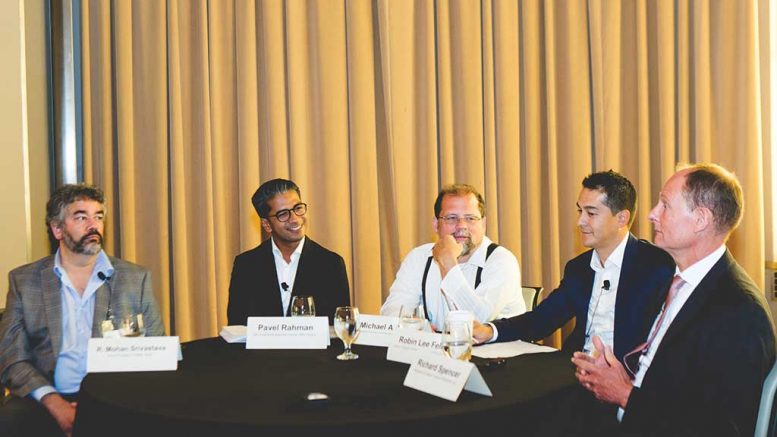VANCOUVER — The exploration industry is on the cusp of a transformation in which artificial intelligence (AI) platforms could dramatically change the way geologists explore for hidden mineral deposits. But will AI ever match or replace the skills of a boots-on-the-ground geologist?
This was one of many topics discussed during a roundtable debate on innovation in exploration at The Northern Miner’s inaugural Progressive Mine Forum in Toronto last October.
Participants in the debate on innovation in exploration were Richard Spencer, president of Aurania Resources (TSXV: ARU); Michael Dehn, consultant at Avanti Management and Consulting; Robin Lee Fell, director of strategic technology solutions at Goldcorp (TSX: G; NYSE: GG); Pavel Rahman, data scientist and associate partner of IBM Canada’s cognitive and advanced analytics solutions; and Mohan Srivastava, vice-president of TriStar Gold (TSXV: TSG; US-OTC: TSGZF).

Northern Miner staff writer Lesley Stokes as moderator for the Exploration Innovation panel at The Northern Miner’s inaugural Progressive Mine Forum in Toronto in 2017. Photo credit: Matthew George Photography.
Both Fell and Rahman are big advocates of IBM’s Watson technology — a computer system capable of answering questions and finding patterns in extremely large data sets — also known as “big data.” They believe this technology will enable geologists to make better exploration decisions, faster.
In fact, Goldcorp is putting AI to the test at its Red Lake gold mine in Ontario. The company has fed Watson with 60 years’ worth of historical data — from drill hole data sets, academic papers and geophysical surveys — in hopes that the “educated” computer could learn the region’s geology and predict where the next big discovery lies.
“AI will not replace geologists, but it can certainly give them a lot of power,” Fell said during the discussion. “If a computer system understands your language, has a background in geology and an understanding of certain deposits, then you’re giving the power of 10,000 geologists to one geologist who is sitting at a computer asking questions.”
But that doesn’t mean that geologists in the future will spend more time behind the computer than in the field, Rahman added. Instead, he says Watson would allow geologists to “do more geology” by lessening the burden of administrative work.
“Let the machines do the data manipulation, information extraction, even some prediction … and let the humans make the judgement calls and the take the actions that are necessary,” Rahman said.
Spencer, a seasoned geologist with multiple discoveries under his belt, pointed out that poor data quality may prevent AI from working efficiently.
“If five of us were logging core, each of us would log differently — our ability to identify the clays that envelop deposits will be different because they all look so similar,” Spencer said. “Until we can get to the position where we’re using some sort of consistent logging system — the automatic loggers, the X-ray fluorescence machines, for example — then there’s going to be a whole lot of bad data that we’ll battle to distinguish from the good data. And I see that as being a massive problem.”
Fell argued the opposite: big data can increase the quality of data sets because it highlights the errors, and provides the functionality to correct mistakes.
“By running large queries you can spot misinterpreted geology in drill core, or pick out certain preferences geologists had over different eras. Big data allows you to modify or normalize those errors and create a cleaner data set for geologists to use,” Fell said.
The discussion shifted to data ownership, whereby Dehn and Srivastava noted their concerns over the exploration and mining industry’s lack of data sharing, and how that might impact the industry’s use of big data and AI.
“You look at what the Energy Resources Conservation Board (ERCB) did in Alberta. There are all kinds of people that camp out at the ERCB offices going through hundreds of thousands of oil wells. But in the mining industry we don’t really have that culture yet of data eventually becoming available for everyone’s use,” Srivastava said.
Fell offered a solution: get Watson to “machine read” publically available assessment reports from government databases.
“These are very long, very difficult-to-read documents that you have to sit down with a coffee and spend a good amount of time going through … if you had a way of being able to ask questions of this information, that would be something that would be very cool for the people to have,” Fell said. “There’s no reason why in the future this platform can’t be a service where people can upload their own data and do their analysis. And maybe Watson is smart enough to provide some pattern recognition and some predictions.”
But the cost of such a service would raise concern among cash-strapped junior explorers, Dehn noted.
“Until we have that first discovery or where you can show an incremental reduction in your cost-per-ounce of discovery, there’s not going to be a huge buy-in to these systems because, as you know, it’s the big companies that are doing it. It’s not the juniors on the street. And the juniors on the street are the ones who are making the discoveries.”






Be the first to comment on "PMF roundtable weighs pros and cons of AI, big data in exploration"